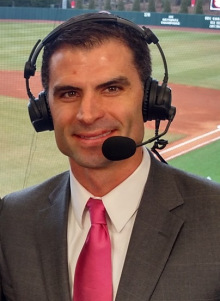
One of the best parts about my job as an ESPN college baseball analyst is that I get to travel around and see the next generation of the game's great players. As a baseball NERD this is quite fun, especially the task of forecasting how a certain player's skills will translate to the next level. The question comes up often, and while nobody is ever 100 percent sure about a prospect, there are some characteristics that I like to focus on to make my evaluation.
Now, I am by no means an expert in this space, and my experience is very much in the development stage as it pertains to projection, but these are the qualities I look for when measuring a college player's chances at having a solid pro career. This issue I will focus on position players (non-pitchers) and in an upcoming issue I will get into pitchers, both starters and relievers.
Projecting Position Players
1) Position profile: There are so many good college players that don't ever make it to the big leagues, and a big part of that is being what some people call a "tweener," meaning they're not quite offensive enough to play their best defensive position, and not quite athletic enough to play a position where their bat would be sufficient. For instance, a really good college third baseman may get to Double A because of their advanced approach and solid defense, but doesn't produce enough runs to hit in the middle of the order and can't run well enough to hit at the top of the order, or play defense in the middle of the field (CF, SS, 2B). To be a top flight prospect, it really helps to have a clearly defined position.
2)Score 'em or Drive 'em in: Along the same lines of position profile, a hitter needs to also project into a certain part of the order. The common thought? To be a REAL PROSPECT, a player must project to either be able to score a bunch of runs, drive in a bunch of runs, or (in the dream scenario) both. These first two categories are why the physical tools of a player are so important. The beautiful thing about college baseball is that it gives evaluators the opportunity to see how a player performs against high level competition so they can begin to see where they might "fit in" at the next level.
3) Career progression: This might catch people off guard, but I like to look at the way a player's college career unfolds when making my projections. By no means is this foolproof, but a player's progression (or lack thereof) can show what type of adjustments they have made during their time on campus. The ability to make adjustments is crucial for success at the next level and if a player doesn't display that in college it's tough to think they will figure that out in pro ball.
4) OPS (on base% + slugging %): Always a great measurement to look at when judging the level at which a hitter will translate. To me there is no substitute for on the field performance. The best players prove it on game day and this statistic is a great measurement for production. If a hitter can't operate at a above average level in this category in college, it's hard to believe he is going to be a difference maker at the next level.
5) Coach's comments: This might be the most important box to check on the projection list. Most coaches is college baseball will shoot you straight when it comes to their players. When I talk to them about their guys I want to know about a player's work habits, leadership skills, ability to handle pressure and failure, baseball aptitude, and internal motivation. While not an exhaustive list these are the personality traits that I believe set a player up to be able to handle the rigors of professional baseball. If they don't pass this test I don't like their chances!
The beauty of projection is that it is an inexact science. Nevertheless, it sure is fun to watch and see which one of these young studs will be able to navigate their way around the pit falls of life in the minor leagues and arrive in "The Show."